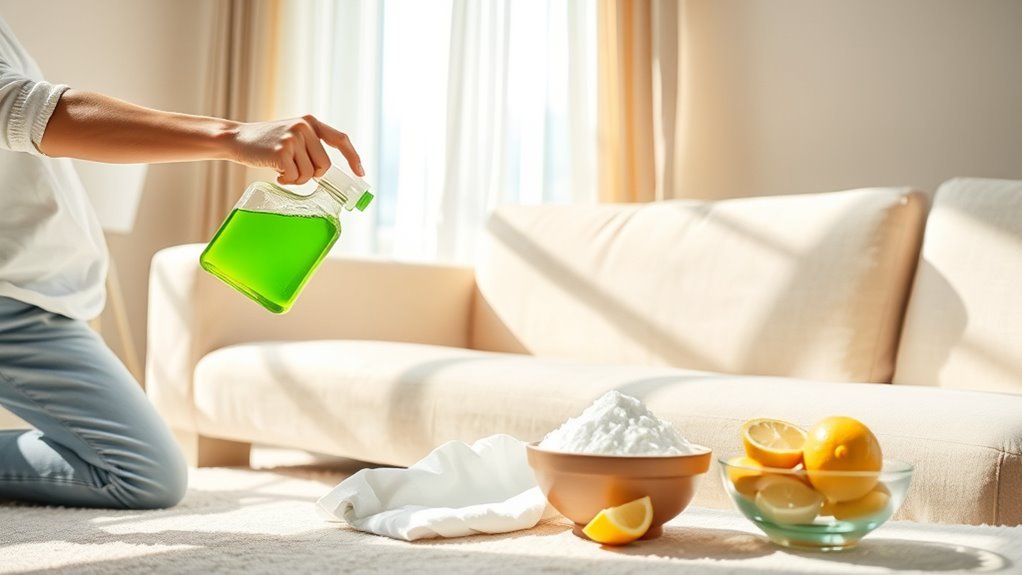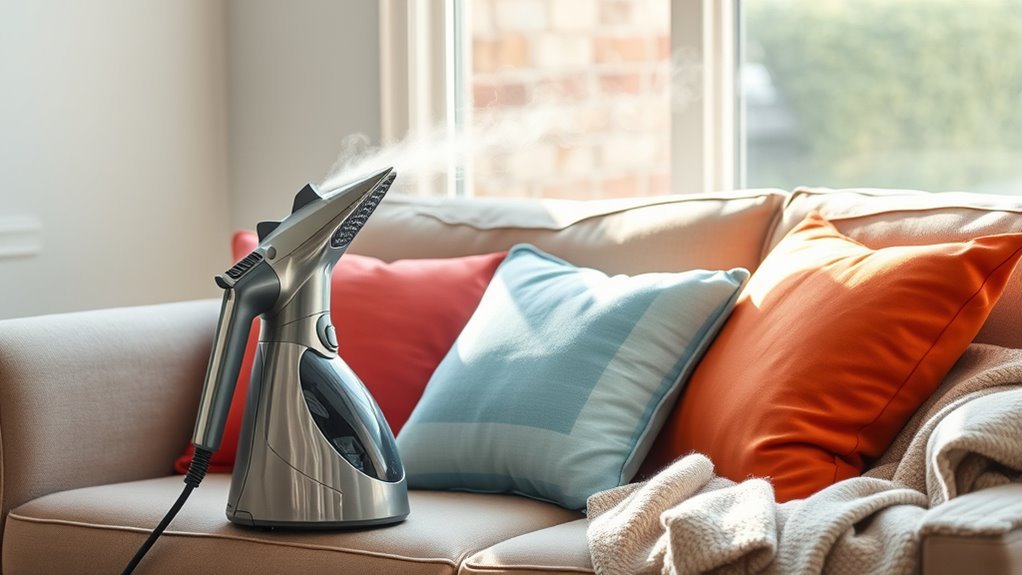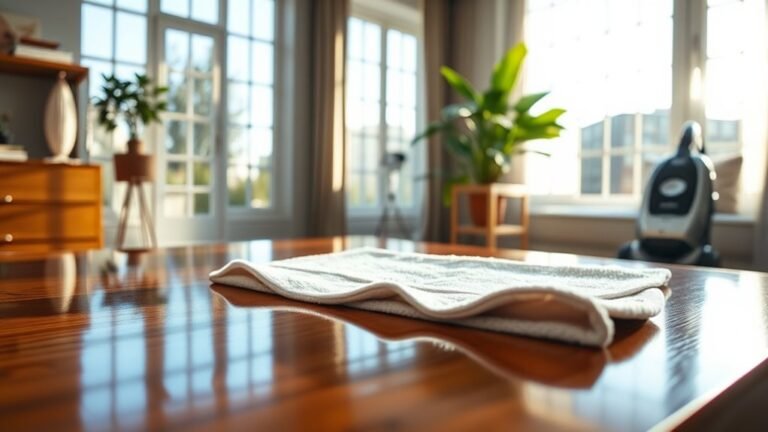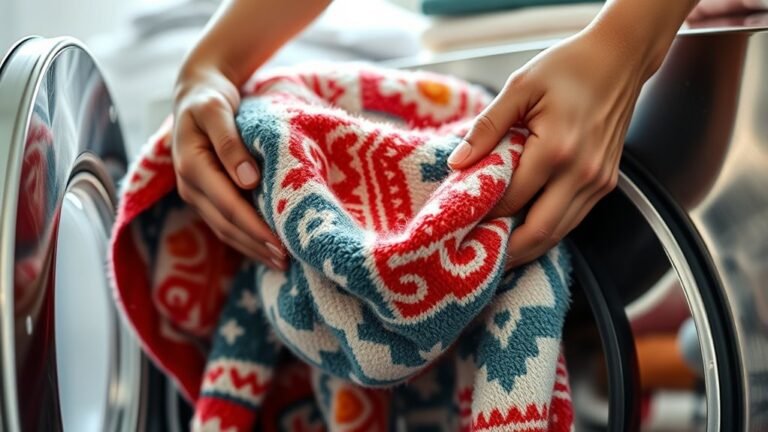How to Clean and Deodorize Your Sofa
To clean and deodorize your sofa, first identify its fabric and gather soft brushes, microfiber cloths, and suitable cleaners. Vacuum thoroughly, focusing on crevices, then spot clean stains with gentle blotting. Use homemade solutions like vinegar-water or dish soap mixes for safe cleaning. Sprinkle baking soda to absorb odors, then vacuum it off. For deep freshness, consider steam cleaning. Allow proper drying to avoid mold. Keep cushions fluffed and spills addressed promptly for lasting freshness. You’ll find even more easy, effective care tips ahead.
Assessing the Fabric Type of Your Sofa

Before you start cleaning, you’ll want to identify the fabric type of your sofa. Knowing this frees you from guessing and protects your sofa’s texture and color. Fabric identification methods include checking the care tag, performing a burn test on a hidden fabric piece, or simply feeling the material. Common fabric types range from natural fibers like cotton and linen to synthetics such as polyester or microfiber. Each reacts differently to cleaning agents, so recognizing your sofa’s fabric helps you choose the safest approach. Don’t rush this step; understanding your sofa’s fabric means you can clean confidently without risking damage—giving you the freedom to enjoy a fresh, inviting space without worry.
Gathering Essential Cleaning Supplies
Before you start cleaning, make sure you have the right tools like soft brushes, microfiber cloths, and a vacuum. Choose cleaners that are safe for your sofa’s fabric to avoid damage. It’s also helpful to prepare a spot treatment for any stubborn stains you might find.
Cleaning Tools Overview
Having the right cleaning tools makes tackling your sofa much easier and more effective. To embrace freedom in your cleaning routine, start with a soft-bristle brush for loosening dirt without damaging fabric. A handheld vacuum with upholstery attachments lets you quickly remove dust and debris, supporting gentle fabric care. Microfiber cloths are your best friends for applying cleaning solutions and blotting stains without spreading them. Don’t forget a spray bottle for homemade cleaners, helping you control the amount of liquid used. These tools empower you to apply varied cleaning techniques confidently, adapting to different fabric types and conditions. With this streamlined kit, you’re ready to refresh your sofa, keeping it fresh and inviting—without complicated products or unnecessary waste.
Selecting Safe Cleaners
Why choose safe cleaners for your sofa? Because your sofa deserves care that protects its fabric and your health without trapping you in harsh chemicals. When selecting cleaners, prioritize eco friendly options—they’re gentle on both your furniture and the planet, giving you freedom from toxic residues. Always check fabric compatibility to avoid damage; what works for cotton might ruin velvet or leather. Look for products labeled safe for your sofa type or opt for natural ingredients like vinegar or baking soda. This way, you maintain your sofa’s look and feel while embracing a cleaning routine that respects your space and values. Choosing safe cleaners lets you clean confidently, keeping your sofa fresh and your home environment pure.
Preparing Spot Treatment
To tackle spot treatment effectively, you’ll need just a few key cleaning supplies that suit your sofa’s fabric. Start with a mild detergent or upholstery cleaner, ensuring it’s safe for your material. Have a spray bottle, clean white cloths, and a soft-bristled brush on hand. These tools make spot treatment techniques easier and more precise. Don’t forget a bowl of warm water to rinse your cloths as you work. Common stains like food, drink, or pet accidents require prompt attention, so keep a stain remover designed for your sofa type nearby. Preparing these supplies ahead of time lets you act quickly and confidently, giving your sofa the fresh look and freedom from odors you want without any hassle.
Vacuuming Your Sofa Thoroughly
Start by attaching the right vacuum tool to reach every part of your sofa. Pay special attention to crevices and seams where dust and crumbs hide. Move the vacuum slowly and methodically to guarantee a deep clean.
Choose the Right Attachment
Although vacuuming your sofa might seem straightforward, choosing the right attachment makes a big difference in how effectively you remove dirt and debris. Different attachment types suit various cleaning methods, so picking the right one lets you clean with ease and freedom. Here’s what to contemplate:
- Upholstery brush: Great for fabric sofas, it loosens dirt without damaging fibers.
- Crevice tool: Perfect for edges and tight spots, it reaches where broad tools can’t.
- Dusting brush: Ideal for delicate surfaces or leather, it gently lifts dust without scratching.
Choosing wisely means you’re not just cleaning—you’re giving your sofa the care it deserves while saving time. Your cleaning routine becomes smoother, letting you enjoy a fresher, freer living space.
Focus on Crevices and Seams
When you vacuum your sofa, paying close attention to crevices and seams guarantees you remove hidden dirt and crumbs that often go unnoticed. Crevice cleaning is essential because these tight spaces trap dust, pet hair, and debris that can affect your sofa’s freshness and longevity. Use a narrow nozzle attachment to reach deep into these areas without damaging the fabric. Seam maintenance is just as important—dirt tends to accumulate along stitching, weakening the material over time. By thoroughly cleaning these sections, you not only improve the sofa’s appearance but also prevent unpleasant odors and wear. Taking the time to focus on crevices and seams will keep your sofa looking and feeling free from hidden grime, making it a welcoming space for relaxation.
Use Slow, Methodical Strokes
Because dirt and dust can settle deep into your sofa’s fabric, you’ll want to use slow, methodical strokes while vacuuming. This methodical approach guarantees you free trapped particles, giving your sofa a thorough clean and a fresher feel. Don’t rush—embrace the freedom that comes with a careful, deliberate cleaning routine.
To maximize your vacuuming:
- Move the vacuum slowly across each section, allowing it to lift hidden debris.
- Overlap your strokes slightly to avoid missing spots.
- Focus on one area at a time, using a methodical approach to cover every inch.
Spot Cleaning Stains Effectively
If you notice a stain on your sofa, acting quickly can make all the difference in preventing it from setting. Whether it’s coffee, wine, or pet accidents—common stain types you’ll encounter—it’s essential to tackle them right away. First, avoid rubbing; instead, use effective blotting techniques to lift the stain gently. Grab a clean cloth or paper towel and press down firmly to absorb as much liquid as possible. Repeat this with fresh cloths until no more transfers. This simple step prevents the stain from spreading or sinking deeper. Remember, patience and precision here grant you freedom from stubborn marks, keeping your sofa looking fresh without harsh scrubbing or expensive treatments. Quick, smart action is your best defense against stains.
Using Homemade Cleaning Solutions

Though commercial cleaners can be effective, you might find that homemade cleaning solutions offer a safer, more affordable alternative for your sofa. Using homemade remedies means you control the ingredients, avoiding harsh chemicals and embracing natural ingredients that protect both your furniture and health. Here are three simple solutions you can try:
- Mix equal parts white vinegar and water for a gentle all-purpose cleaner.
- Combine a few drops of mild dish soap with warm water to lift dirt without damaging fabric.
- Use a solution of water and lemon juice for a fresh, natural antiseptic cleaner.
These options give you freedom from harsh chemicals while keeping your sofa clean and fresh. Plus, they’re easy to make with items you likely already have at home.
Deodorizing With Baking Soda
Along with homemade cleaning solutions, baking soda is a simple and effective way to deodorize your sofa. One of the biggest baking soda benefits is its natural ability to neutralize odors without harsh chemicals, giving you fresh-smelling furniture without compromising your freedom from toxins. To use this method, sprinkle a generous layer of baking soda evenly over your sofa’s surface. Let it sit for at least 15-20 minutes—or longer if you have the time—allowing the baking soda to absorb trapped smells. Then, vacuum thoroughly to remove all residue. This deodorizing technique is quick, affordable, and safe, making it a go-to option for maintaining a clean, inviting space. By using baking soda, you’re choosing an easy way to refresh your sofa whenever you need.
Steam Cleaning for Deep Freshness

Steam cleaning is one of the most effective ways to give your sofa a deep, thorough refresh. By harnessing high-temperature steam, you can break down dirt and kill bacteria without harsh chemicals. The steam cleaning benefits go beyond surface cleaning—it penetrates fabric fibers, eliminating allergens and odors trapped deep inside. To get the most freedom from your sofa’s dirt:
- Pre-treat stains with a mild solution to loosen grime.
- Use a handheld steam cleaner with adjustable settings for control.
- Move the steam nozzle slowly to allow deep steam penetration.
Mastering these steam cleaning techniques lets you reclaim your sofa’s freshness and enjoy a healthier, more inviting living space.
Drying and Maintaining Your Sofa
After cleaning your sofa, it’s crucial to dry it properly to prevent mold and mildew growth. You can speed up the drying process by opening windows or using fans to circulate air around your sofa. Avoid direct sunlight, which can fade the fabric, and skip heat sources that might damage the material. Choosing the right drying methods guarantees your sofa stays fresh and intact. For maintenance tips, vacuum your sofa regularly to remove dust and debris, and promptly address spills to avoid stains setting in. Fluff cushions to maintain shape and air out the sofa to keep it smelling clean. By sticking to these drying methods and maintenance tips, you’ll enjoy a fresh, comfortable sofa that lasts longer and feels like a true freedom zone in your home.
Preventive Tips to Keep Your Sofa Fresh Longer
To keep your sofa smelling fresh and looking great for longer, you’ll want to incorporate simple preventive habits into your routine. Preventive maintenance not only saves time but also extends your sofa’s life, letting you enjoy your space freely without constant worry. Here are three essential tips:
- Apply Fabric Protection: Use a fabric protector spray to shield your sofa from spills and stains, making cleaning easier and preventing odors from settling in.
- Regular Vacuuming: Vacuum your sofa weekly to remove dust, dirt, and allergens that can cause unpleasant smells and degrade fabric quality.
- Use Slipcovers or Throws: These add an extra layer of protection and are easy to wash, keeping your sofa fresh without hassle.
Stick to these habits and your sofa will stay inviting and clean, giving you more freedom to relax and enjoy.
Frequently Asked Questions
Can I Use Commercial Upholstery Cleaners Safely on All Sofa Fabrics?
You can use commercial upholstery cleaners, but you’ve got to assess fabric compatibility first. Not all fabrics react the same way, so checking the cleaner ingredients is key to avoid damage. Some cleaners might be too harsh for delicate materials like silk or velvet. Always test a small hidden area before going all in. This way, you maintain freedom in cleaning without risking your sofa’s look or feel.
How Often Should Professional Cleaning Services Be Used for Sofas?
You’ll want to follow frequency recommendations based on your sofa’s use and fabric type. Generally, getting professional cleaning services every 12 to 18 months keeps things fresh without hassle. When choosing a service, focus on their expertise and eco-friendly options to maintain your freedom from harsh chemicals. This way, you enjoy a clean sofa without sacrificing your lifestyle. Trust your instincts and select a service that fits your needs and schedule.
What Are the Best Methods to Remove Pet Hair From Sofas?
If you’re dealing with pet hair on your sofa, start with vacuum techniques that use a brush attachment to loosen fur effectively. Don’t skip the corners and crevices where hair hides. After vacuuming, grab a lint roller to pick up any stubborn strands remaining on the surface. This combo gives you freedom from pet hair without hassle, keeping your space fresh and inviting. You’ll feel more relaxed knowing your sofa looks great.
Are There Specific Cleaning Tips for Leather Sofas Versus Fabric Ones?
Did you know leather sofas can last over 20 years with proper leather care? When cleaning leather, you’ll want to avoid harsh chemicals—just use a damp cloth and specialized leather cleaner. Fabric maintenance is different; you can vacuum regularly and spot-clean with mild detergent. Each needs its own approach, so you’re free to keep your sofa looking fresh and comfy without risking damage. Understanding these tips helps you enjoy your space longer.
Can Sofa Cleaning Products Cause Allergies or Skin Irritation?
Yes, sofa cleaning products can sometimes cause allergy symptoms or skin reactions, especially if you’re sensitive to certain chemicals or fragrances. You’ll want to check ingredient labels and maybe test a small area first to avoid discomfort. If you have a history of allergies, choosing hypoallergenic or natural cleaners can give you more freedom to freshen up your space without worrying about unwanted skin reactions or sneezing fits.






